Short and Long Question Answers: Hamara Bharat - Incredible India! | Short & Long Answer Questions for Class 6 PDF Download
Short Answer Questions
Q1: What is the "Ek Bharat, Shreshtha Bharat" programme about?
Ans: The "Ek Bharat, Shreshtha Bharat" programme is an initiative aimed at promoting mutual understanding and unity between people from different states and Union Territories (UTs) in Bharat. It focuses on state/UT pairing to celebrate the diversity of India, including its languages, cuisines, music, dance, and handicrafts. This programme encourages the sharing of best practices and experiences to enhance interaction and build emotional bonds between citizens from different regions. The idea is to develop a sense of common identity, celebrating India’s rich diversity while strengthening national unity and contributing to nation-building.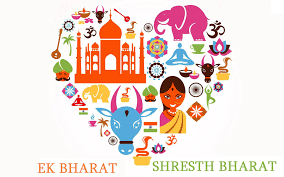
Q2: What materials are used to make Dhokra art?
Ans: Dhokra is a 4000-year-old metal craft practiced by a tribe in Odisha. It begins with making a figure from clay, which is then covered with a layer of wax. Fine details are carved onto the wax, and the figure is covered with clay again before being placed in the fire. The wax melts and exits through small openings, and molten brass scrap is poured into the empty space to take the shape of the wax. Once the clay layer is removed, the metal figure is finished and polished. The main materials used in this process include clay, wax, and brass scrap.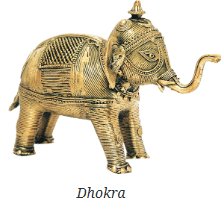
Q3: What is the significance of coconut shell craft in Kerala?
Ans: Coconut shell craft is a traditional craft of Kerala where artisans use the shells of coconuts to create household items and jewelry. The process begins by cleaning both the inside and outside of the coconut shell. The shell is then polished and shaped into desired forms, with a stable base fixed under it. Finally, it is polished with wood polish to give it a shiny finish. This eco-friendly and biodegradable craft has become an important part of Kerala's culture, promoting sustainable practices and creative expression.
Q4: How are Kondapalli toys made in Andhra Pradesh?
Ans: Kondapalli toys are traditional wooden toys made in Andhra Pradesh. The process begins by taking soft wood from nearby hills and carving each part of the toy separately. The parts are then joined together using a paste made from tamarind seed powder and sawdust. After adding details, the toys are painted with oil, watercolors, or vegetable dyes. These toys often represent folk stories, animals, birds, rural life, and more. The craft is an important cultural tradition and has been passed down for generations.
Q5: Why does Akanksha’s family make Aipan?
Ans: Akanksha’s family makes Aipan as part of their cultural tradition during family functions and festivals. This art form, which is typically created using rice flour paste on walls, is not only an aesthetic practice but also holds cultural significance. Aipan designs are inspired by nature and traditional mathematical patterns, passed down through generations. By making Aipan, Akanksha’s family keeps this traditional folk art alive, celebrating cultural identity and creating a spiritual and festive atmosphere during important occasions.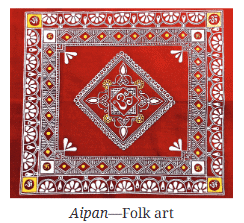
Q6: What is common between Kondapalli toys and coconut shell craft in Kerala?
Ans: Both Kondapalli toys and coconut shell craft in Kerala involve traditional, eco-friendly materials and are deeply rooted in cultural practices. Kondapalli toys are carved from soft wood and painted with natural dyes, often reflecting rural life, animals, and folk stories. Coconut shell craft, on the other hand, uses natural coconut shells to create decorative and functional items, which are polished and shaped into beautiful products. Both crafts are passed down through generations and promote sustainability, showcasing local resources and creativity.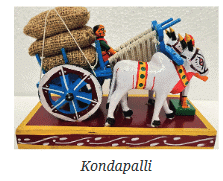
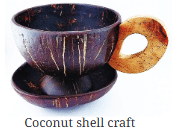
Long Answer Questions
Q1: Describe how different art forms represent the culture of their respective states.
Ans: In Bharat, art forms represent the rich cultural heritage and traditions of different regions. For instance, Aipan art from Uttarakhand, created during festivals and family functions, features geometric and nature-inspired designs, reflecting the people’s connection to their environment. Dhokra craft from Odisha, with over 4000 years of history, uses clay, wax, and brass to create intricate metal figures, showcasing the region's ancient metalworking skills and tribal culture.
In Kerala, coconut shell craft transforms shells into functional and decorative items, promoting eco-friendly practices. Kondapalli toys from Andhra Pradesh, made from soft wood and bright paints, represent rural life and folk tales, highlighting the region's relationship with nature and traditions.
Each art form tells the story of its people, their values, and culture, serving as a reflection of their unique identity.
Q2: What is the role of the Ek Bharat, Shreshtha Bharat programme in enhancing India’s unity?
Ans: The Ek Bharat, Shreshtha Bharat programme aims to enhance national unity by promoting understanding among people from different states and Union Territories of Bharat. By pairing states and UTs, it encourages cultural exchange and strengthens emotional bonds, celebrating the unity in diversity.
This initiative encourages citizens to appreciate the cultural practices, languages, festivals, and art forms of other regions, fostering a deeper connection across Bharat. It emphasizes shared values and traditions, helping build a more united and inclusive country.
The programme also contributes to nation-building by promoting collaboration in education, health, and social development, creating a stronger, cohesive society.
Q3: Explain the significance of cultural exchange through art forms in fostering unity.
Ans: Cultural exchange through art plays a key role in fostering unity by helping people understand and appreciate each other's traditions and values. In Bharat, each state has its unique art forms that reflect its cultural identity. Sharing these art forms allows individuals to experience the country's rich diversity and promote mutual respect.
For example, Aipan from Uttarakhand, Dhokra from Odisha, and coconut shell craft from Kerala showcase the creativity of different regions. These art forms are linked to local customs, festivals, and beliefs, deepening the connection to their traditions.
Through cultural exchange, people can find common ground, celebrate diversity, and learn that, despite differences, all communities contribute to Bharat's collective identity. These art forms carry the stories and struggles of the people, and by celebrating them, Bharat's unity is strengthened, highlighting diversity as the nation's greatest strength.
FAQs on Short and Long Question Answers: Hamara Bharat - Incredible India! - Short & Long Answer Questions for Class 6
| 1. भारत की संस्कृति में विविधता का क्या महत्व है? |  |
| 2. Incredible India! अभियान का उद्देश्य क्या है? |  |
| 3. भारत के प्रमुख त्योहार कौन से हैं और उनका महत्व क्या है? |  |
| 4. भारत में पर्यटकों के लिए कौन से प्रमुख स्थल हैं? |  |
| 5. भारतीय भोजन की विशेषताएँ क्या हैं? |  |
















